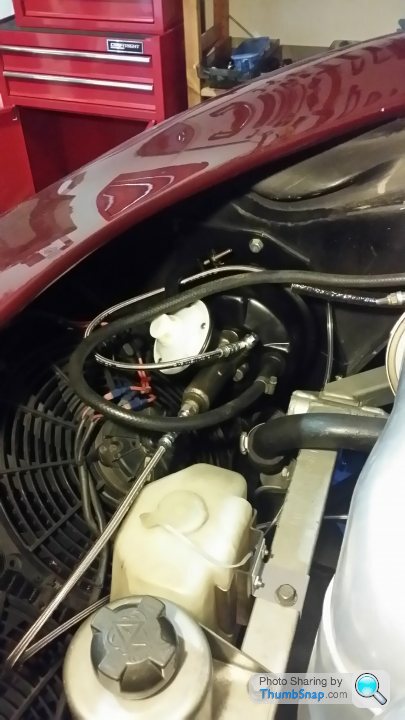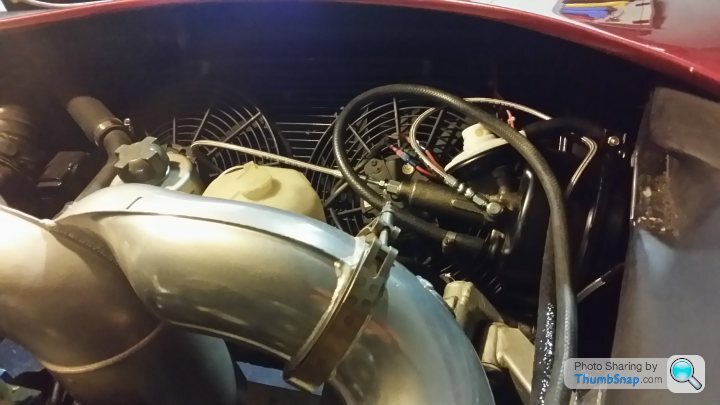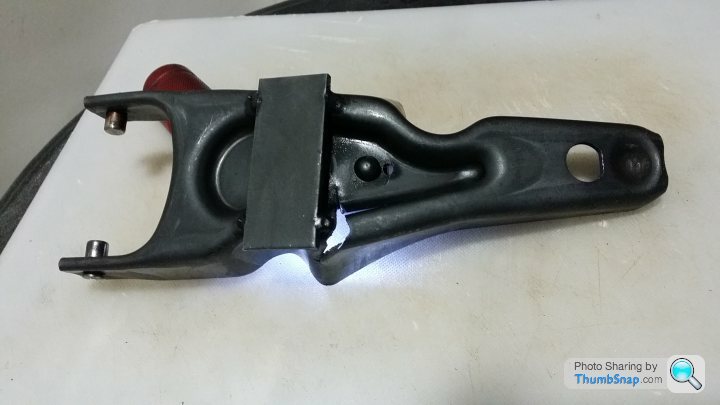Clutch lightening Servo - BEWARE
Discussion
I followed this prior topic with interest and having a competition clutch and being an "old codger", decided the remote clutch servo was a good idea. Bought the MGB 1.65 servo and carefully installed where the the screen washer sits (It is a Griff 500 and too big for where the carbon canister fits)


I replaced the master cylinder seals, replaced the slave (pitted), new flrxible hoses, etc. Bled the system, very soft pedal and squishy so pumped the master to feel some pressure. Now, I was aware that there is no "stop limit" with this installation, but managed to completely crack open the clutch fork!! (Only replaced in 2013 due to fulcrum pivot punch hole.) Sh** and Bu**** was all I could say !!
 |http://thumbsnap.com/VaE5boPv[/url]
|http://thumbsnap.com/VaE5boPv[/url]
I was all set for a spin this wk-end. Now having split the engine from the bell housing, managed to remove the fork. Next question "Do I limit the movement?" It should not be necessary as nothing physical has changed in the movement ratio's.
The master is 0.7" bore, the slave is 1" bore, so from what I see (A= pi x r squared) that gives a 1:0.5 movement ratio, ie. 1' at master and 1/2 inch at the slave.
Introducing the Servo at 1:65 - not yet sure how to translate that ratio? Being single line remote should be straight through?
The maximum movement at the slave - full-in to full-out appears to be 2" (Hence the damage.)
Any hydraulic experts on here?
Do I put a limiter on the clutch pedal?
Do I have to change bores?
Did I damage during bleeding?
I also note the original pipe was 1/4". The new flexible hose is less. Will this affect the pedal return speed?
Any suggestions welcome.


I replaced the master cylinder seals, replaced the slave (pitted), new flrxible hoses, etc. Bled the system, very soft pedal and squishy so pumped the master to feel some pressure. Now, I was aware that there is no "stop limit" with this installation, but managed to completely crack open the clutch fork!! (Only replaced in 2013 due to fulcrum pivot punch hole.) Sh** and Bu**** was all I could say !!
 |http://thumbsnap.com/VaE5boPv[/url]
|http://thumbsnap.com/VaE5boPv[/url]I was all set for a spin this wk-end. Now having split the engine from the bell housing, managed to remove the fork. Next question "Do I limit the movement?" It should not be necessary as nothing physical has changed in the movement ratio's.
The master is 0.7" bore, the slave is 1" bore, so from what I see (A= pi x r squared) that gives a 1:0.5 movement ratio, ie. 1' at master and 1/2 inch at the slave.
Introducing the Servo at 1:65 - not yet sure how to translate that ratio? Being single line remote should be straight through?
The maximum movement at the slave - full-in to full-out appears to be 2" (Hence the damage.)
Any hydraulic experts on here?
Do I put a limiter on the clutch pedal?
Do I have to change bores?
Did I damage during bleeding?
I also note the original pipe was 1/4". The new flexible hose is less. Will this affect the pedal return speed?
Any suggestions welcome.
Edited by DaveG on Sunday 22 January 19:25
Edited by DaveG on Sunday 22 January 19:50
I bought a 1.65 and am going to be fitting it too in the next couple of weeks.
My clutch though is standard not competition, so hopefully I wont have this problem. Or will I?
Looking at the job in hand though, I took off the cover plate this morning that is over the clutch fluid filler cap, and assume that the small pipe going into the side of this is where the pipe from the remote servo comes from? I cant see anything else that is accessible to connect to.The pipe to the slave unit is easily accessible by the looks of it.
I plan to fit mine where the carbon canister currently is, under the headlight.
My clutch though is standard not competition, so hopefully I wont have this problem. Or will I?
Looking at the job in hand though, I took off the cover plate this morning that is over the clutch fluid filler cap, and assume that the small pipe going into the side of this is where the pipe from the remote servo comes from? I cant see anything else that is accessible to connect to.The pipe to the slave unit is easily accessible by the looks of it.
I plan to fit mine where the carbon canister currently is, under the headlight.
Hi Jazzdude. The competition clutch makes no difference, maybe a bit heavier under pedal. You will not fit the servo where the canister is under the wing - it is too large at least on the Griffith. I removed the canister a few yrs back ( I have MS / ECU etc.) I made up a custom cover plate to replace the one supporting the washer bottle and on which to mount the servo. Yours being a Chimaera, may fit under the wing??
Email Engineer1949 on here. He fitted mine and I have not had one problem with it in 25,000 miles. John is a skilled engineer and happy to give advice. He will most likely be able to tell you where the issue is, I think.
His profile is here I have clicked "email me" for you.
He has built a supercharged Chimaera from the ground up for his son, a rather nice Wedge, and is presently building an LS engined Cerbera.
His profile is here I have clicked "email me" for you.
He has built a supercharged Chimaera from the ground up for his son, a rather nice Wedge, and is presently building an LS engined Cerbera.
Some others have also fitted this servo as was on the thread where I got this info from and they also have not had any issues.
If you do get a response from Engineer 1949 I would appreciate your sharing it here too.
Just a quick query though, was there a reason you used a different diameter of tubing than the one already on the car, and is the point on the mastercylinder you connected to, the small pipe that goes in just under the filler cap?
If you do get a response from Engineer 1949 I would appreciate your sharing it here too.

Just a quick query though, was there a reason you used a different diameter of tubing than the one already on the car, and is the point on the mastercylinder you connected to, the small pipe that goes in just under the filler cap?
The clutch piping is a larger bore than the brake system.
If you are using brake pipe diameter you will achieve more movement in the arm.
There are also different design bore slaves.
Standard TVR is 1", (25mm) although the Rover alternatives are identical in dimensions but only 7/8", (22mm) bore, again giving more movement, (and more effort!).
If you are using brake pipe diameter you will achieve more movement in the arm.
There are also different design bore slaves.
Standard TVR is 1", (25mm) although the Rover alternatives are identical in dimensions but only 7/8", (22mm) bore, again giving more movement, (and more effort!).
phazed said:
The clutch piping is a larger bore than the brake system.
If you are using brake pipe diameter you will achieve more movement in the arm.
There are also different design bore slaves.
Standard TVR is 1", (25mm) although the Rover alternatives are identical in dimensions but only 7/8", (22mm) bore, again giving more movement, (and more effort!).
I thought the bore size would have something to do with it. If you are using brake pipe diameter you will achieve more movement in the arm.
There are also different design bore slaves.
Standard TVR is 1", (25mm) although the Rover alternatives are identical in dimensions but only 7/8", (22mm) bore, again giving more movement, (and more effort!).
 The OP is right to comment on the different sizes and I would be interested to hear what size pipe they put on your car Qbee.
The OP is right to comment on the different sizes and I would be interested to hear what size pipe they put on your car Qbee.Edited by jazzdude on Monday 23 January 13:12
Edited by jazzdude on Monday 23 January 13:14
Sorry, cannot help at the present - car away having a heart transplant. All I remember is it is a thin copper capilliary tube that runs to/from the swervo.
I may be seeing it later in the week, so will measure, but in the mean time do email John with your questions and I am sure he will help you.
I may be seeing it later in the week, so will measure, but in the mean time do email John with your questions and I am sure he will help you.
QBee said:
Sorry, cannot help at the present - car away having a heart transplant. All I remember is it is a thin copper capilliary tube that runs to/from the swervo.
I may be seeing it later in the week, so will measure, but in the mean time do email John with your questions and I am sure he will help you.
just sent John an email I may be seeing it later in the week, so will measure, but in the mean time do email John with your questions and I am sure he will help you.

Pipe diameter should not affect the amount of measured movement, since once bled and full of fluid, if pressing the pedal displaces X cc of fluid from the master cylinder, then X cc of fluid will enter the slave cylinder giving a linear piston movement that is determined by relative cylinder bore size. If it does not, then there's air in there.
Pipe size is larger on clutch circuits though to allow the fluid to move back and forth fast since relative to a brake circuit a lot more fluid moves. Using small bore pipe will slow the movement of the fluid and tend to slow the operation of the clutch, possibly leading to clutch slip in worst cases. Been there before. 😏
Pipe size is larger on clutch circuits though to allow the fluid to move back and forth fast since relative to a brake circuit a lot more fluid moves. Using small bore pipe will slow the movement of the fluid and tend to slow the operation of the clutch, possibly leading to clutch slip in worst cases. Been there before. 😏
Hi Jazzdude, yes, servo now working. Regards the pipe sizes, the original master-to-slave is 1/4 ins. I have replaced the original pipe with flexible brake hoses, which is what the servo requires. These are 3/16 ins. The consequence of this is probably that the pedal return is 'slowed' a little, otherwise the clutch is smooth and sensitive.
The other changes I had to make were to re-orientate the servo to exactly match the installation instructions (problems with bleeding.) I also found that the return spring in the new slave was much weaker than the original, so I used the original and to better position the slave piston in its cylinder I also added a couple of shims (1/8 ins) to the slave mounts.
Also a note concerning the 'smashed' release fork, I managed to remove and replace this without dropping the gearbox. It would not come out of the inspection hole due to bending of the fork, however by separating the gearbox from the engine (ie release g/b from bell housing) you can slide the gearbox back about 1"ins on the prop shaft. This gives enough room to manouver the fork through the inspection hole. Note also that it is a real pig getting the fork back and aligned and onto the release bearing and correctly sited onto the pivot. (I have done it twice now in 3 years - more than enough!!).
The other changes I had to make were to re-orientate the servo to exactly match the installation instructions (problems with bleeding.) I also found that the return spring in the new slave was much weaker than the original, so I used the original and to better position the slave piston in its cylinder I also added a couple of shims (1/8 ins) to the slave mounts.
Also a note concerning the 'smashed' release fork, I managed to remove and replace this without dropping the gearbox. It would not come out of the inspection hole due to bending of the fork, however by separating the gearbox from the engine (ie release g/b from bell housing) you can slide the gearbox back about 1"ins on the prop shaft. This gives enough room to manouver the fork through the inspection hole. Note also that it is a real pig getting the fork back and aligned and onto the release bearing and correctly sited onto the pivot. (I have done it twice now in 3 years - more than enough!!).
That's good news as mine is arriving anyday now and I will also be fitting it.
Interesting that you decided to use flexible 3/16 instead of rigid 1/4 brake pipes. Do you think if I used the latter the slow return issue will be there also?
I must admit the bit you described about changing the orientation and using the original spring confused me. I was under the impression that the installation involved fitting the remote servo in between the master and slave and then connecting the vacuum to the plenum. I wasn't aware you had to open anything up or maybe I misunderstood this.
Interesting that you decided to use flexible 3/16 instead of rigid 1/4 brake pipes. Do you think if I used the latter the slow return issue will be there also?
I must admit the bit you described about changing the orientation and using the original spring confused me. I was under the impression that the installation involved fitting the remote servo in between the master and slave and then connecting the vacuum to the plenum. I wasn't aware you had to open anything up or maybe I misunderstood this.
Hi Jazzdude, I do not think you have read the whole thread. I had to split the engine to replace the release fork, previously damaged. You are correctly stating that the brake servo sits inline between the master and the slave. The original pipe (1/4ins) runs between the master and the slave. The servo uses standard brake fittings and 3/16 ins pipe and so I used banjo connectors at the 'block' for the master and also for the slave connection.
I still do not quite understand how I managed to break the release fork, but I did. The clutch movement is determined by the ratio of the bores in the master and the slave and so this should not change. The servo should not change this (1:1) only the force required.
(Note there seems to be quite a few variation of slave in use if you intend changing the slave.)
I still do not quite understand how I managed to break the release fork, but I did. The clutch movement is determined by the ratio of the bores in the master and the slave and so this should not change. The servo should not change this (1:1) only the force required.
(Note there seems to be quite a few variation of slave in use if you intend changing the slave.)
Ok that's clearer now.
I also see that using flexible pipes make things easier too. I'll take the existing 1/4 inch pipe and the servo to a hydraulic pipe fabricator and get 2 lengths made up to fit through the inner wheel arch to the master then a longer one to continue to the slave.
Was bleeding straightforward?
I also see that using flexible pipes make things easier too. I'll take the existing 1/4 inch pipe and the servo to a hydraulic pipe fabricator and get 2 lengths made up to fit through the inner wheel arch to the master then a longer one to continue to the slave.
Was bleeding straightforward?
Gassing Station | Chimaera | Top of Page | What's New | My Stuff





